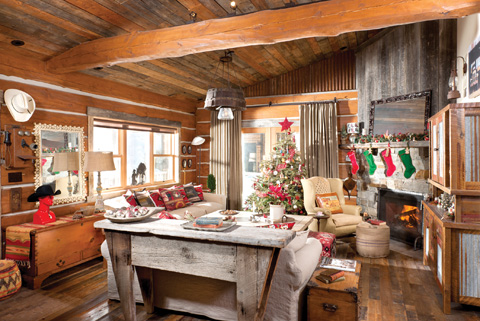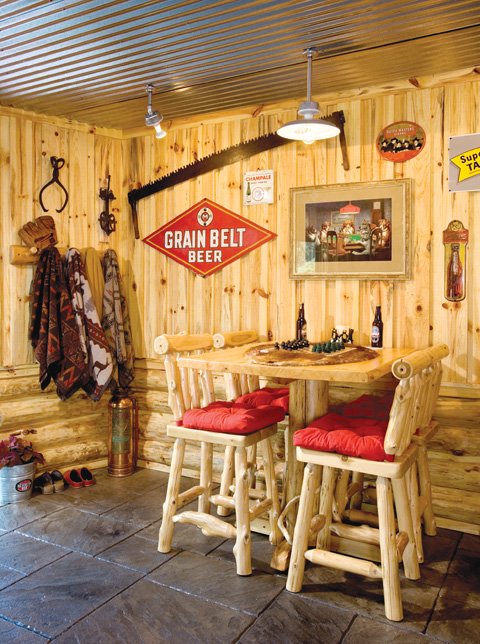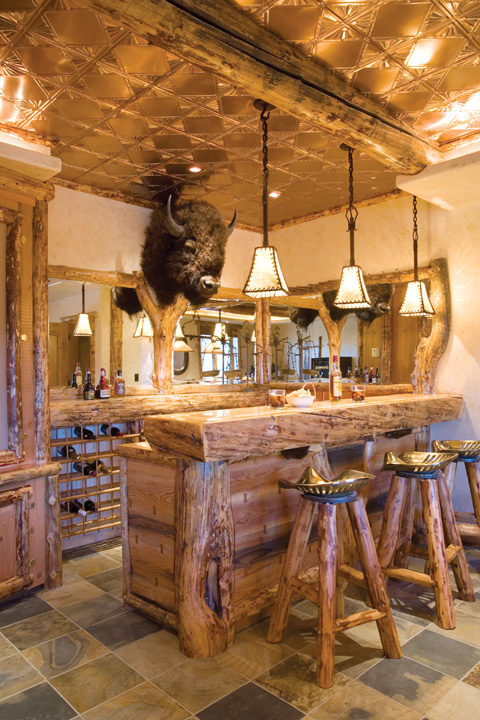Often, homeowners spend so much of their creative energy on floors and fixtures, walls and windows, that ceilings become an afterthought. But ceilings can make a big impact on the overall look and feel of a room. The right ceiling can brighten up a dim space or lend a den-like coziness, depending on the material you choose.
Many homeowners are mixing up ceiling materials from room to room, to give each room its own character. “I’ve seen clients use anything from drywall to metal,” says Celeste Raygosa, design manager for PFB Custom Homes in Meridian, Idaho. “As a personal preference, I really like the metal look because I like to use a mix of materials and textures in my designs,” she says. “Some clients have used a corrugated metal for a more industrial look, while others have used a pressed tin for an old-time, rustic look.”
Keep in mind that some materials work better than others in rooms that will have recessed lighting or other structural considerations, so it’s important to have a discussion with your log or timber frame home designer before you set your heart on a specific ceiling material. As with every home design choice there will be tradeoffs no matter what you decide on.

Photo by Perry Mastrovito
Paint & Wallpaper
If you are not satisfied with a traditional drywall ceiling painted a matte white, there are many other ways to achieve a unique ceiling using paint. A paint color that contrasts with your logs and timbers will enhance the structure of your home. If you find that the log walls make a room feel dark, then keeping the ceiling light will accentuate its height and give the room a more airy feeling. Today paint is available in a variety of textures, everything from a suede look to the appearance of textured plaster. You can achieve the look you want with a single paint or create a faux finish with a variety of paints.
It is a bit more challenging to install wallpaper on a ceiling, but the effect can be worth the effort. If you want a floral or geometric pattern on the ceiling, consider using anaglypta wallpaper. It installs like standard wallpaper but can be painted to fit your decor. Wallpaper is produced in thousands of different styles and patterns; you can find everything from a simple solid paper to a textured grasscloth to a metallic.
Metal Ceiling Materials
Tin ceiling tiles are an incredibly versatile choice. While we often think of the tin ceilings that were popular in the 1900s, today’s tin-plated steel tiles come in a broad range of patterns and colors, so you can customize the look you want. Patterns are typically stamped in. Opt for a decorative floral pattern to transform a room into a vintage Victorian, or choose a pattern with clean geometric lines for a more contemporary home.
Look for powder-coated rather than painted tin tiles for a baked-in coating that will last for a lifetime. Finishes come in metal finishes like silver, copper, gold, and brass, or colors like black, brown, white, and ivory. The most common size for tin ceiling tiles is 24×24 but you can also find smaller 12×12 tiles. Installation is not complicated; you can nail them up or drop them in, but you may want to install a sound dampener underneath to help absorb sound in the room.

Photo by Heidi Long
Tin is durable and requires little to no maintenance to keep it looking new. Occasional cleaning with mild soap and water should do the trick! Like tin ceiling tiles, aluminum tiles come in a variety of colors and patterns. Also like tin, aluminum is durable and easy to care for, plus it won’t rust.
Tin tiles of varying patterns and styles are also available in styrofoam or PVC and can be glued or dropped in place. They weigh less than the real metal tiles and cost less as well. They come in a variety of metallic or distressed finishes or they can be painted in any color you desire.
Copper’s earthy warmth makes it a natural complement to the wood used in log and timber homes. Because solid copper requires a major investment, you may find that what is advertised as copper is actually copper-finished tin. Solid copper will age over time to a rich patina. Make sure you know which you are purchasing!
If you want the look of copper without the expense, look for styrofoam or PVC tiles with a copper finish; they are available with a high sheen surface or one with an aged patina.
Corrugated metal has a distinctive, eye-catching appearance that works for homes that range from rustic to industrial. Often made from old barn roofs, they can be found to fit any standard ceiling grid. Corrugated tiles that are recycled from a previous use will be unique, adding character to any room. Salvaged corrugated metal can be found in a spectrum of hues, allowing you to pick and choose for a more uniform ceiling, or use random hues for a patchwork effect.
Newly fabricated corrugated metal is also available for ceiling use, which will give you a more refined, modern look and feel. It can be left in its natural state that should be preserved with a sealant, or it can be painted in any finish and color to suit your décor.

Golden Eagle Log Homes/photo by Roger Wade
Wood
Rustic reclaimed wood is a natural fit for a log and timber home, and adds a touch of character and history. Variations in old barnwood created by time and weather ensure a one-of-a-kind ceiling that will lend warmth and charm to any room, while reclaimed tongue-and-groove flooring will have a cleaner, more consistent look.
Traditional beadboard ceilings are a classic design element that can give a home a coastal New England feel. Great with everything from country cottage to casual beach décor, beadboard is traditionally found in white but can be painted any color to match your interior design. You should run beadboard ceiling panels in the same direction as your hardwood floors to make rooms feel open and spacious.
If you watch HGTV you are mostly likely familiar with shiplap, which is often found inside the walls of old homes. It can be reclaimed and used on ceilings with dramatic effect. It can be left in its natural color and finish, painted, or whitewashed so the grain shows through. If you can’t find reclaimed shiplap you can achieve the same effect with new wood stained to give it an antique appearance. The new boards can also be painted or whitewashed.

